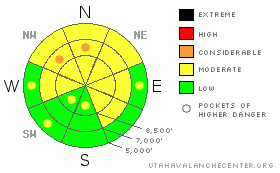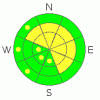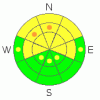AVALANCHE WATCH »
The risk of an avalanche is expected to increase significantly
but the timing and location are still uncertain. Stay tuned for updates.
|
 |
Notice: Heavy snowfall starting this evening and continuing through Sunday will increase the avalanche danger Sunday and Monday in the backcountry. |
|
|
BOTTOM LINE
Danger by aspect and elevation on slopes approaching 35° or steeper.
(click HERE for tomorrow's danger rating)
|

Danger Rose Tutorial
|
There's a level 2 or Moderate danger in the Logan Zone. Heightened avalanche conditions exist, and dangerous triggered avalanches are still possible. You could trigger wind slab avalanches in upper elevation terrain exposed to drifting, and large and destructive hard slab avalanches are possible on isolated slopes with generally shallow snow and poor snow structure, especially on very steep slopes facing the northern half of the compass. Evaluate the snow and terrain carefully, and continue to avoid very steep slopes facing the northern half of the compass and drifted slopes at upper elevations. Once again, you'll find safer conditions in sheltered areas, on south facing slopes, at lower elevations, and in lower angled terrain.. |
|
|
CURRENT CONDITIONS |

|
Riding conditions are good and smooth, with mostly supportable snow under several inches of fluffy powder, and you can ride almost anywhere you want to.. Northwest winds at upper elevations drifted the snow around a bit in the Central Bear River Range yesterday morning, and observers mention rimed snow in the Logan Peak Area. The shallow powder is certainly still nice and fast, and you can find great conditions in much safer lower angled terrain... It's 20 degrees up at the 8400' Tony Grove Snotel, and there is 69 inches of total snow on the ground containing 78% of normal water for the date. The Campbell Scientific Logan Peak weather station at 9700' reports 16 degrees this morning, with west winds averaging around 15 mph... |
|
|
RECENT ACTIVITY |

|
We could see evidence of numerous loose dry avalanches or sluffs Thursday on steep slopes at upper elevations in the Tony Grove Area. One of these, in Castle Rock, looks to have stepped down to last week's weak snow surface, perhaps taking out a shallow soft slab as it ran. Earlier in the week, we triggered a couple large audible collapses in lightly traveled mid elevation northwest facing terrain with a generally thin snowpack. Very weak faceted snow or depth hoar still plagues many slopes in the area, and dangerous hard slab avalanches are still quite possible in isolated areas.
(go to our current conditions page for more details on local activity and reports of other recent avalanches in Utah) |
|
|
THREAT #1 |

|
| WHERE |
PROBABILITY |
SIZE |
TREND |

|
|
|
|
| |
|
|
Over the next
24 hours.
|
|
|
You'll find a rising danger of wind slabs in upper elevation areas exposed to drifting. In many cases drifts are building up on top of shallowly buried suspect weak snow that was on the surface in early February. A couple layers of feathery surface hoar crystals and widespread small sugary near surface facet grains were preserved by the light snowfalls last week. Soft and stiffer wind slabs today could be up to around a foot deep and are most likely forming on the lee sides of major ridge lines and in and around terrain features like sub-ridges, gullies, scoops, and cliff bands. It is possible that a shallow wind slab overrunning a slope with poor snow structure could cause a much larger and more dangerous deep slab avalanche... |
|
|
THREAT #2 |

|
| WHERE |
PROBABILITY |
SIZE |
TREND |

|
|
|
|
| |
|
|
Over the next
24 hours.
|
|
|
You still might trigger a dangerous hard slab avalanche on a very steep slope facing the northern half of the compass, particularly in areas with generally shallow snow... Watch for and avoid shallow or rocky terrain at upper and mid elevations, and keep in mind that you are most likely to trigger a hard slab avalanche from an area where the slab layer is relatively thin. Large audible collapses or whumpfing, like those my party triggered earlier in the week, indicate the presence of a persistent weak layer and potentially very unstable snow. It is possible the weight of a single person could be enough to trigger a large avalanche, and you might trigger one remotely, from a distance or below. Other slopes will need a bigger trigger or someone to hit the so called, "sweet spot", probably from a shallower part of the slab, which could cause an entire bowl to avalanche even if there are already tracks in it.... |
|
|
MOUNTAIN WEATHER |

|
Snowfall will become heavy at times starting this evening and continuing through much of tonight.. Expect daytime high temperatures of around 27 degrees at 8500' with 10 to 20 mph southwest winds and snow possible this afternoon. 6 to 12 inches of accumulation is currently forecast by Sunday afternoon, and more is certainly possible.. The bulk of the snowfall and moderately strong gusty southwest winds will occur tonight. It looks like more snow will fall in the Central and Southern Mountains, with a foot or less of accumulation likely in mountain areas north of I-80. Regardless. this storm will certainly cause a general increase in backcountry avalanche danger in the Logan Zone and across the state.... It will also open the door for a moist and breezy weather pattern, which will bring a continuing threat of more snowfall and winds to our area through much of next week. |
|
|
GENERAL ANNOUNCEMENTS |
Please consider a donation to your favorite non-profit –The Friends of the Utah Avalanche Center. The Utah Avalanche Center depends on contributions from users like you to support our work.....
Please send us your observations from the backcountry especially if you see or trigger an avalanche, but also even if you don't.. go to avalanche and snow observations. You can also call me directly at 435-757-7578 or leave us a message at our office, 801-524-5304.... And, you can always send us a simple email by clicking HERE
I will update this advisory by around 7:30 in the morning on Mondays, Wednesdays, Fridays, and Saturdays.....
This advisory is from the U.S.D.A. Forest Service, which is solely responsible for its content. This advisory describes general avalanche conditions and local variations always occur. |
|
|
This information does not apply to developed ski areas or highways where avalanche control is normally done. This advisory is from the U.S.D.A. Forest Service, which is solely responsible for its content. This advisory describes general avalanche conditions and local variations always occur. |
|
This advisory provided by the USDA Forest Service, in partnership with:
The Friends of the Utah Avalanche Center, Utah Division of State Parks and Recreation, Utah Division of Emergency Management, Salt Lake County, Salt Lake Unified Fire Authority and the friends of the La Sal Avalanche Center. See our Sponsors Page for a complete list. |



